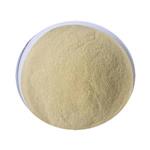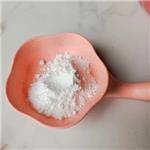Light yellow to cream or beige powder or flakes. N,N'-o-Phenyleneguanidine [934-32-7], 2-aminobenzimidazole, C7H7N3, Mr 133.15, mp 231 – 232 ℃(decomp.), obtained by cyclization of o-phenylenediamine with cyanogen chloride or cyanamide, is the nucleus for a number of compounds of economic interest.
2-Aminobenzimidazole was used in the hydrolysis of a choline carbonate. It was also used in the synthesis of imidazo[1,2-a]benzimidazoles.
ChEBI: 2-aminobenzimidazole is a member of the class of benzimidazoles that is benzimidazole in which the hydrogen at position 2 is replaced by an amino group. It has a role as a marine xenobiotic metabolite.
Synthesis of 2-aminobenzimidazole: Cyanogen bromide (3.5 g., 0.034 mole) was added in small portions, with shaking, to a suspension of o-phenylenediamine (4.2 g. , 0.34 mole) in water (40 ml), the exothermic reaction mixture was cooled to room temperature and it was stirred for 36hrs. The solution was filtered after standing overnight. Sodium hydroxide (1.4 g., 0.034 mole) in 30 ml of water was then added and the solution was evaporated. The solid thus obtained was filtered and recrystalized from water. Yield 85%, m.p. 228 - 230°C
Plates (in water); white powder.
2-Aminobenzimidazole neutralizes acids in exothermic reactions to form salts plus water. May be incompatible with isocyanates, halogenated organics, peroxides, phenols (acidic), epoxides, anhydrides, and acid halides. May generate hydrogen, a flammable gas, in combination with strong reducing agents such as hydrides.
ACUTE/CHRONIC HAZARDS: When heated to decomposition 2-Aminobenzimidazole emits toxic fumes of nitrogen oxides.
Flash point data for 2-Aminobenzimidazole are not available; however, 2-Aminobenzimidazole is probably combustible.
Poison by intravenous and intraperitoneal routes. Moderately toxic by ingestion. An experimental teratogen. Mutation data reported. When heated to decomposition it emits toxic NO,. See also AROUTIC AMINES.



